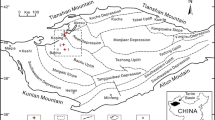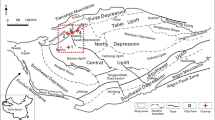Abstract
Based on their lithologic characteristics and stratal geometries, the Middle Cambrian Fasham and Deh-Sufiyan Formations of the lower Mila Group in the Central Alborz, northern Iran, exhibit 39 lithofacies representing several supratidal to deep subtidal facies belts. The siliciclastic successions of the Fasham Formation are divided into two facies associations, suggesting deposition in a tide-dominated, open-mouthed estuarine setting. The mixed, predominantly carbonate successions of the Deh-Sufiyan Formation are grouped into ten facies associations. Four depositional zones are recognized on the Deh-Sufiyan ramp: basinal, outer ramp (deep subtidal associations), mid ramp (shallow subtidal to lower intertidal associations), and inner ramp (shoal and upper intertidal to supratidal associations). These facies associations are arranged in small-scale sedimentary cycles, i.e., peritidal, shallow subtidal, and deep subtidal cycles. These cycles reflect spatial differences in the reaction of the depositional system to small-scale relative sea-level changes. Small-scale cycles are stacked into medium-scale cycles that in turn are building blocks of large-scale cycles. Systematic changes in stacking pattern (cycle thickness, cycle type, and facies proportion) allow to reconstruct long-term changes in sea-level. Six large-scale cycles (S1–S6) have been identified and are interpreted as depositional sequences showing retrogradational (transgressive systems tract) and progradational (highstand systems tract) packages of facies associations. The six depositional sequences provide the basis for inter-regional sequence stratigraphic correlations and have been controlled by eustatic sea-level changes.












Similar content being viewed by others
References
Aghanabati A (2004) Geology of Iran. Geological Survey of Iran, Tehran, p 434 (in Persian)
Alavi M (1996) Tectonostratigraphic synthesis and structural style of the Alborz mountain system in northern Iran. J Geodyn 21:1–33
Assereto R (1963) The Paleozoic formations in central Elburz (Iran) (Prelim. note). Rivista Italiana Paleontologia e Stratigrafia 69(4):503–543
Bádenas B, Aurell M, Bosence D (2010) Continuity and facies heterogeneities of shallow carbonate ramp cycles (Sinemurian, Lower Jurassic, north-east Spain). Sedimentology 57:1021–1048
Bosence D, Procter E, Aurell M, Bel Kahla A, Boudagher-Fadel M, Casaglia F, Cirilli S, Mehdie M, Nieto L, Rey J, Scherreiks R, Soussi M, Waltham D (2009) A dominant tectonic signal in high-frequency, peritidal carbonate cycles? A regional analysis of Liassic platforms from western Tethys. J Sediment Res 79:389–415
Brett CE, Allison PE, DeSantis MK, Liddell WD, Kramer A (2009) Sequence stratigraphy, cyclic facies, and lagerstätten in the Middle Cambrian Wheeler and Marjum formations, Great Basin, Utah. Palaeogeogr Palaeoclimatol Palaeoecol 277:9–33
Burchette TP, Wright VP (1992) Carbonate ramp depositional systems. Sediment Geol 79:3–57
Burgess PM (2001) Modeling carbonate sequence development without relative sea-level oscillations. Geology 29:1127–1130
Burgess PM, Wright VP, Emery D (2001) Numerical forward modeling of peritidal carbonate parasequence development: implication for outcrop interpretation. Basin Res 13:1–16
Carpentier C, Lathuiliere B, Ferry S (2010) Sequential and climatic framework of the growth and demise of a carbonate platform: implications for the peritidal cycles (Late Jurassic, north-eastern France). Sedimentology 57:985–1020
Chen D, Tucker ME, Jiang M, Zhu J (2001) Long-distance correlation between tectonic-controlled, isolated carbonate platforms by cyclostratigraphy and sequence stratigraphy in the Devonian of South China. Sedimentology 48:57–78
Dalrymple RW, Zaitlin BA, Boyd R (1992) Estuarine facies models: conceptual basis and stratigraphic implications. J Sediment Petrol 62:1130–1146
Elicki O (1999) Palaeoecological significance of calcimicrobial communities during ramp evolution: an example from the Lower Cambrian of Germany. Facies 41:27–40
Elicki O, Hamann Y, Münzberger P (2003) Biofazies, Paläoökologie und Ablagerungsmodell des Finalstadiums einer kambrischen Karbonatplattform-Entwicklung: die Fauna der Campo Pisano Formation SW-Sardiniens. Freiberger Forschungshefte 499:1–33
Elrick M (1995) Cyclostratigraphy of Middle Devonian carbonates of the eastern Great Basin. J Sediment Res 65:61–79
Flügel E, Munnecke A (2010) Microfacies of carbonate rocks, analysis interpretation and application. Springer, Berlin Heidelberg New York, p 984
Fürsich FT, Wilmsen M, Seyed-Emami K, Cecca F, Majidifard MR (2005) The upper Shemshak formation (Toarcian–Aalenian) of the Eastern Alborz (Iran): biota and palaeoenvironments during a transgressive–regressive cycle. Facies 51:365–384
Gámez JA, Férnandez-Nieto C, Gozalo R, Liñán E, Mandado J, Palacios T (1991) Bioestratigrafía y evolución ambiental del Cámbrico de Borobia (Provincia de Soria, Cadena Ibérica Oriental). Cuadernos de Laboratorio Xeológico de Laxe 16:251–271
Geyer G, Elicki O, Fatka O, Żylińska A (2008) Cambrian. In: McCann T (ed) The Geology of Central Europe, vol 1., Precambrian and Palaeozoic. Geological Society of London, London, pp 155–202
Geyer G, Bayet-Goll A, Wilmsen M, Mahboubi A, Moussavi-Harami R (2014) Lithostratigraphic revision of the middle and upper Cambrian (Furongian) in northern and central Iran. Newsl Stratigr (in press)
Ghavidel-Syooki M (2006) Palynostratigraphy and palaeogeography of the Cambro-Ordovician strata in southwest of Shahrud City (Kuh-e-Kharbash, near Deh-Molla), Central Alborz Range, northern Iran. Rev Palaeob Palynol 139:81–95
Ghienne J-F, Monod O, Kozlu H, Dean WT (2010) Cambrian–Ordovician depositional sequences in the Middle East: a perspective from Turkey. EarthSci Rev 101:101–146
Hallam A (1992) Phanerozoic sea-level changes. Columbia University Press, New York
Hamdi B (1995) Precambrian–Cambrian deposits in Iran. In: Hushmandzadeh A (ed) Treatise on the Geology, vol 20. pp 353 (in Persian)
Hamdi B, Rozanov AYu, Zhuravlev AYu (1995) Latest Middle Cambrian metazoan reef from northern Iran. Geol Mag 132:367–373
Hamon Y, Merzeraud G (2008) Facies architecture and cyclicity in a mosaic carbonate platform: effects of fault-block tectonics (Lower Lias, Causses platform, south-east France). Sedimentology 55:155–178
Handford CR, Loucks RG (1993) Carbonate depositional sequences and systems tracts-responses of carbonate platforms to relative sea-level changes. In: Loucks RG, Sarg JF (eds) Carbonate sequence stratigraphy. Amer Assoc Petrol Geol Mem 57:3–41
Haq BU, Schutter SR (2008) A chronology of Paleozoic sea-level changes. Science 322:64–68
Harris PT, Heap AD, Bryce SM, Porter-Smith R, Ryan DA, Heggie DT (2002) Classification of Australian clastic coastal depositional environments based upon a quantitative analysis of wave, tidal, and river power. J Sediment Res 72:858–870
Howley RA, Rees MN, Jiang GX (2006) Significance of Middle Cambrian mixed carbonate-siliciclastic units for global correlation: southern Nevada, USA. Palaeoworld 15:360–366
Jacobs DK, Sahagian DL (1995) Milankovitch fluctuations in sea level and recent trends in sea-level change: ice may not always be the answer. In: Haq BU (ed) Sequence stratigraphy and depositional response to eustatic, tectonic and climatic forcing: Dordrecht. Kluwer, The Netherlands, pp 329–366
James NP, Stevens RK, Barnes CR, Knight I (1989) Evolution of a Lower Paleozoic continental-margin carbonate platform, northern Canadian Appalachians. In: Crevello PD, Wilson JL, Sarg JF, Read JF (eds) Controls on carbonate platform and basin development. SEPM Spec Publ 42:123–146
Kwon YK, Chough SK, Choi DK, Lee DJ (2006) Sequence stratigraphy of the Taebaek Group (Cambrian–Ordovician), mideast Korea. Sediment Geol 192:19–55
Landing E (2012) Extended abstract—the great American carbonate bank in eastern Laurentia: its births, deaths, and linkage to paleooceanic oxygenation (Early Cambrian–Late Ordovician). In: Derby JR, Fritz, RD, Longacre SA, Morgan WA, Sternbach CA (eds) The great American carbonate bank: the geology and economic resources of the Cambrian–Ordovician Sauk megasequence of Laurentia: Amer Assoc Petrol Geol Memoir, vol 98. pp 253–260
Landing E, Geyer G, Heldmaier W (2006) Distinguishing eustatic and epeirogenic controls on Lower–Middle Cambrian boundary successions in West Gondwana (Morocco and Iberia). Sedimentology 53:899–918
Landing E, Geyer G, Buchwaldt R, Bowring SA (2014) Geochronology of the Middle Cambrian: a precise U-Pb zircon date from the German margin of West Gondwana. Geological Magazine (in press)
Lasemi Y (2001) Facies analysis, depositional environments and sequence stratigraphy of the Upper Pre-Cambrian and Paleozoic rocks of Iran. Tehran, Geological Survey of Iran, p 180 (in Persian)
Lasemi Y, Amin-Rasouli H (2002) Microfacies and depositional environments of the storm deposits in the lower part of member 2 of the Mila formation in Tuyeh-Darvar area. Univ Tehran J Sci 28:33–52 (in Persian with English abstract)
Lasemi Y, Jahani D, Amin-Rasouli H, Lasemi Z (2012) Ancient carbonate tidalites. In: Davis RA, Dalrymple RW (eds) Principles of tidal sedimentology. Springer, Berlin Heidelberg New York, pp 567–607
Lee HS, Chough SK (2011) Depositional processes of the Zhushadong and Mantou formations (Early to Middle Cambrian), Shandong Province, China: roles of archipelago and mixed carbonate–siliciclastic sedimentation on cycle genesis during initial flooding of the North China platform. Sedimentology 58:1530–1572
Mei MX, Ma YS, Zhang H, Meng XQ, Chen YH (2007) Sequence stratigraphic framework for the Cambrian of the Upper Yangtze region: ponder on the sequence stratigraphic background of the Cambrian biological diversity events. J Stratigr 31:68–78 (in Chinese)
Meng X, Ge M, Tucker ME (1997) Sequence stratigraphy, sea-level changes and depositional systems in the Cambro-Ordovician of the North China carbonate platform. Sediment Geol 114:189–222
Mergl M, Geyer G, El-Attari A (1998) The billingsellid genus Saccogonum (Brachiopoda) from the Moroccan Cambrian and its significance for the regional geology and stratigraphy. N Jahrb Geol Paläont Abh 209:273–293
Miller KG, Kominz MA, Browning JV, Wright JD, Mountain GS, Katz ME, Sugarman PJ, Cramer BS, Christie-Blick N, Pekar SF (2005) The Phanerozoic record of global sea-level change. Science 310:1293–1298
Mitchum RM Jr, Van Wagoner JC (1991) High-frequency sequences and their stacking patterns: sequence stratigraphic evidence of high-frequency eustatic cycles. Sediment Geol 70:131–160
Montañez IP, Banner JL, Osleger DA, Borg LE, Bosserman PJ (1996) Integrated Sr isotope variations and sea-level history of Middle to Upper Cambrian platform carbonates: implications for the evolution of Cambrian seawater 88Sr/86Sr. Geology 24:917–920
Mount JF, Kidder D (1993) Combined flow origin of edgewise intraclast conglomerates. Sellick Hill Formation (Lower Cambrian), South Australia. Sedimentology 40:315–329
Osleger DA, Montañez IP (1996) Cross-platform architecture of a sequence boundary in mixed siliciclastic–carbonate lithofacies, Middle Cambrian, southern Great Basin, USA. Sedimentology 43:197–217
Osleger D, Read JF (1991) Relation of eustasy to stacking patterns of meter-scale carbonate cycles, Late Cambrian, USA. J Sediment Petrol 61:1225–1252
Palmer AR, James NP (1980) The Hawke Bay event: a circum-Iapetus regression near the Lower–Middle Cambrian boundary. In: Wones DR (ed) The Caledonides in the USA. Department of Geological Sciences, Virginia Polytechnic Institute and State University Memoir, vol 2. pp 15–18
Peng S, Geyer G, Hamdi B (1999) Trilobites from the Shahmirzad section, Alborz Mountains, Iran: their taxonomy, biostratigraphy and bearing for international correlation. Beringeria 25:3–66
Pillola GL (1991) Trilobites du Cambrieninférieur du SW de la Sardaigne, Italie. PalaeontographicaItaliana 78:1–178
Plint AG (1991) High-frequency relative sea level oscillations in Upper Cretaceous shelf clastics of the Alberta foreland basin: possible evidence for a glacio-eustatic control? IAS Spec Publ 12:409–428
Schlager W (2005) Carbonate sedimentology and sequence stratigraphy. SEPM Concepts Sedimentol Paleontol 8:200
Sim MS, Lee Y (2006) Sequence stratigraphy of the Middle Cambrian Daegi formation (Korea), and its bearing on the regional stratigraphic correlation. Sediment Geol 191:151–169
Stöcklin J, Ruttner A, Nabavi M (1964) New data on the Lower Paleozoic and pre-Cambrian of North Iran. Geol Surv Iran, Report no. 1, pp 29
Strasser A, Pittet B, Hillgärtner H, Pasquier JB (1999) Depositional sequences in shallow carbonate-dominated sedimentary systems: concepts for a high-resolution analysis. Sed Geol 128:201–221
Taylor AM, Goldring R (1993) Description and analysis of bioturbation and ichnofabric. J Geol Soc London 150:141–148
Tucker M, Garland J (2010) High-frequency cycles and their sequence stratigraphic context: orbital forcing and tectonic controls on Devonian cyclicity Belgium. Geol Belg 13(3):213–240
Tucker ME, Wright VP (1990) Carbonate sedimentology. Blackwell, Oxford, p 482
Acknowledgments
Financial support and field expenses, provided to Aram Bayet-Goll by the Geology Department, Ferdowsi University of Mashhad, are gratefully acknowledged. The contribution of Gerd Geyer has been supported by research grant GE 549/21-1 of the Deutsche Forschungsgemeinschaft (DFG). We thank the journal reviewers O. Elicki (Freiberg) and E. Landing (Albany, NY) as well as journal editor M. Tucker for helpful comments on the manuscript, and Hamed Mohamadian, Hasan Khazaiee, and Yaghub Nasiri for their assistance during field work.
Author information
Authors and Affiliations
Corresponding author
Rights and permissions
About this article
Cite this article
Bayet-Goll, A., Geyer, G., Wilmsen, M. et al. Facies architecture, depositional environments, and sequence stratigraphy of the Middle Cambrian Fasham and Deh-Sufiyan Formations in the central Alborz, Iran. Facies 60, 815–841 (2014). https://doi.org/10.1007/s10347-014-0401-9
Received:
Accepted:
Published:
Issue Date:
DOI: https://doi.org/10.1007/s10347-014-0401-9




